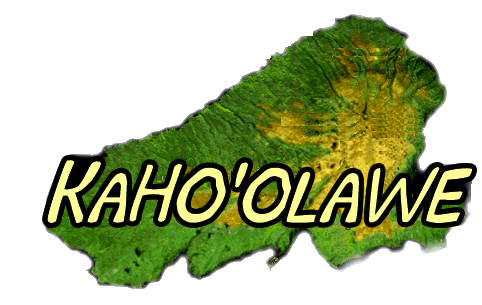
Home
Introduction to Kaho'olawe
PowerPoint
Introduction
Kaho'olawe Surveyor Software
Development Team
Role Cards
Key Elements for Reinhabiting
the Island
Presentation
Assessment
Related readings:
|
ENVIRONMENT
& EROSION FLORA
AND FAUNA
Flora and Fauna on the Island: One plant in particular deserves mention. It was discovered by scientists from the Pacific Tropical Botanical Garden in a very isolated, difficult to reach location on the island. Initial findings indicate that the plant is a new genus found only previously in pollen samples that date to the 14th and 15th centuries, but then disappeared. This plant is a remnant from an earlier time.(KICCR, 66) Kaho`olowe's earliest vegetation seems to have been characterized by a lowland dry shrub land community, probably with a few widely scattered large shrubs or small trees. Late in prehistory, or, perhaps, early in the historic period after 1778, the shrub land was replaced largely by a grassland community as a result of anthropogenic (human) burning. This condition has quickly transformed Kaho`olowe into its present day appearance, which is characterized by a greatly reduced grasslands community and a largely barren wasteland on the inland plateau resulting form ungulate grazing. The new plant genus has survived all this. The Commission's recommendation to the scientific community that this genus be named Ka Palupalu o Kanaloa (the gentleness of Kanaloa) has been accepted. Scientific descriptions of the new plant are in process.(KICCR, 67) Kaho`olowe still possesses some for the best natural plant communities in the state. One such community comprised a native cotton, ma`o (Gossypium tomentosum). Critical habitat for Kaho`olowe's flora estimated at 20 percent of the island, or about 5,600 acres. (KICCR, 67) Flora and Fauna in Surrounding Waters: The waters surrounding Kaho`olowe are an integral part of the island environment. It is clear that Native Hawaiians used the island's resources and those in its surrounding waters to meet their daily needs. Fish, opihi [limpet], crabs, limu [seaweed], and various other forms of ocean life were all important in maintaining the Hawaiian diet. Implements were fashioned from shell, and coral had significant religious connotations., The island's currents and winds were, likewise, specifically known to ancient Hawaiians and appear in ancient legends and chants. The fact that the island is intimately linked with the Hawaiian deity, Kanaloa, strengthens this relationship with the sea. The numerous ko`a [fishing shrines] and ku`ula [stone images used to attract fish, also the name of a fishing god], as well as the writings of A.D. Kahaulelio, a 19th century fisherman and historian, attest to this relationship as well. (KICCR, 75) Kaho`olowe's surrounding waters also serve as habitat for a number of marine reptiles and mammals, most of which are listed on the federal government's endangered species list. These included green sea turtles or honu (Chelonia mydas); Hawaiian monk seals, or `ilio holo i ka uaua (Monachus schauinslandi); porpoises, or naia (Stenella longirostris); and humpback whales, or kohola (Megaptera novaeangliae). In 1992, the US Congress created the Hawai`i Island Humpback Whale National Marine Sanctuary. The waters surrounding Kaho`olowe were excluded from the sanctuary pending further study of the unexplored ordnance in these waters. The National Oceanic and Atmospheric Administration (NOAA) will make a determination of whether these waters are eligible for inclusion within the sanctuary in 1996. If found to be eligible, negotiations between NOAA and the Kaho`olowe administrating authority will be required at theappropriate time. (KICCR, 75) KICCR: Kaho`olawe: Restoring a Cultural Treasure. Final Report of the Kaho`olawe Island Conveyance Commission to the Congress of the United States. March 31,1993. |
